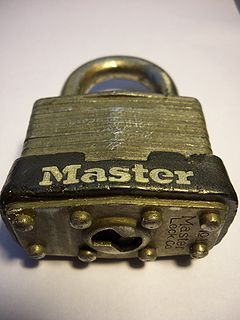Master Lock No 1: Difference between revisions
Oaklandishh (talk | contribs) (Created page with '== Master Lock No1 == thumb|alt=A Master Lock Commercial, one of the different varieties of Master Lock No 1. The '''Master Lock No 1''' is a very …') |
(Thanks to Oaklandishh for starting this page : )) |
||
| Line 1: | Line 1: | ||
= Master Lock No. 1 = | |||
{{Lock model | |||
| name = Master Lock No. 1 | |||
| Img = File:Mastercommercial.JPG | |||
| maker = [[Master Lock]] | |||
| lock_type = [[Padlock]], [[Cylinder]] | |||
| lock_design = [[Pin-tumbler]] | |||
| years_produced = | |||
| patent = | |||
| related = | |||
}} | |||
The '''No. 1''' is a [[pin-tumbler]] [[padlock]] made by [[Master Lock]]. The No. 1 uses a laminated padlock body with an internal key-in-knob [[cylinder]]. The inner cylinder uses four pin stacks and does not use any [[security pin]]s. The No. 1 is one of the most common low security padlocks used in the United States. | |||
The | |||
__TOC__ | |||
== Principles of operation == | |||
== | The M1 cylinder is a [[pin-tumbler]] lock with 4 pin stacks. It does '''NOT''' contain any [[security pin]]s unless otherwise modified. | ||
The No. 1 padlock uses the [[M1]] [[key blank]], but also can be made with a slightly different key profile. This change in profile helps to stop people from making copies of keys they shouldn't have. | |||
== Disassembly instructions == | |||
The No. 1 cannot be disassembled non-destructively. To disassemble it, the rivets that hold the laminated body together must be removed and each layer removed individually. The inner cylinder itself can be disassembled in the same manner as a traditional pin-tumbler lock: | |||
{{Pin-tumbler standard disassembly}} | |||
'''Notes''' | |||
* The No. 1 cylinder requires a small diameter plug follower. | |||
== Vulnerabilities == | |||
The No. 1 is vulnerable to a wide range of attacks. The reduced pin tumbler count and poor manufacturing tolerances makes it an easy lock to pick. It's commonly given to [[locksport]] beginners as a "confidence lock"; a lock that is easy to open and inspires you to continue picking. The No. 1 may be vulnerable to one or more of the following: | |||
* [[Lockpicking]] | |||
* [[Key bumping]] | |||
* [[Impressioning]] | |||
* [[Decoding]] | |||
* [[Bypass]] | |||
* [[Destructive entry]] | |||
== Gallery == | |||
<div align="center"><gallery> | |||
File:cutawaym1.JPG|A cutaway No. 1 padlock and cylinder. | |||
</gallery></div> | |||
== See also == | |||
* [[Padlock]] | |||
* [[Pin-tumbler]] | |||
* [[Master Lock]] | |||
[[Category:Padlocks]] | |||
[[Category:Master Lock|No 1]] | |||
[[Category:Pin-tumbler locks]] | |||
Revision as of 21:52, 17 August 2010
Master Lock No. 1
| Master Lock No. 1 | |
 | |
| Name | Master Lock No. 1 |
|---|---|
| Manufacturer | Master Lock |
| Lock Type | Padlock, Cylinder |
| Lock Design | Pin-tumbler |
The No. 1 is a pin-tumbler padlock made by Master Lock. The No. 1 uses a laminated padlock body with an internal key-in-knob cylinder. The inner cylinder uses four pin stacks and does not use any security pins. The No. 1 is one of the most common low security padlocks used in the United States.
Principles of operation
The M1 cylinder is a pin-tumbler lock with 4 pin stacks. It does NOT contain any security pins unless otherwise modified.
The No. 1 padlock uses the M1 key blank, but also can be made with a slightly different key profile. This change in profile helps to stop people from making copies of keys they shouldn't have.
Disassembly instructions
The No. 1 cannot be disassembled non-destructively. To disassemble it, the rivets that hold the laminated body together must be removed and each layer removed individually. The inner cylinder itself can be disassembled in the same manner as a traditional pin-tumbler lock:
- Remove the cam or C-clip.
- Insert the key and turn the plug 45-90 degrees.
- Withdraw the plug from the cylinder. (A plug follower is recommended)
OR
- Remove the chamber casings and take out each pin-stack individually
- Remove the cam or C-clip.
- Withdraw the plug from the cylinder.
Notes
- The No. 1 cylinder requires a small diameter plug follower.
Vulnerabilities
The No. 1 is vulnerable to a wide range of attacks. The reduced pin tumbler count and poor manufacturing tolerances makes it an easy lock to pick. It's commonly given to locksport beginners as a "confidence lock"; a lock that is easy to open and inspires you to continue picking. The No. 1 may be vulnerable to one or more of the following:
